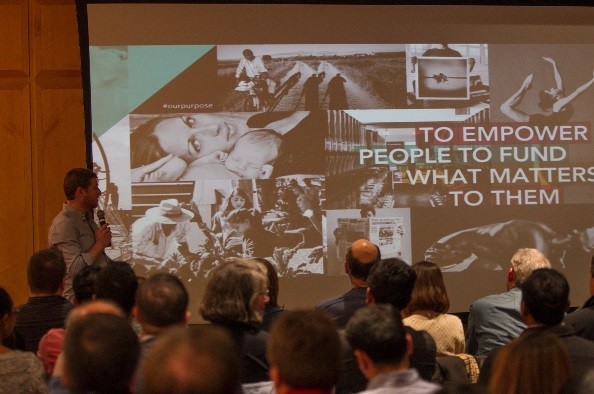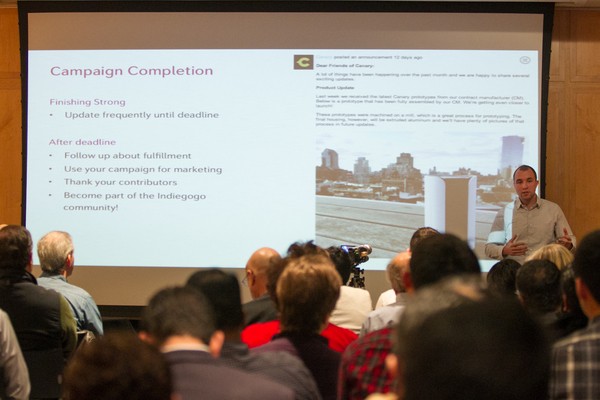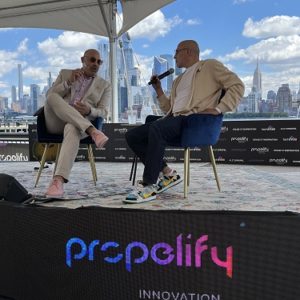Indiegogo Execs Give Crowdfunding Advice at Princeton Tech Meetup

To hear Stefan Kende describe it, crowdfunding clears the path for entrepreneurs to pursue their dreams without being quashed by so-called gatekeepers.
“Our goal is to democratize the raising of capital,” said Kende, a manager at San Francisco-based crowdfunding vehicle Indiegogo, at the March 25, 2014, Princeton Tech Meetup. “The idea of gatekeepers deciding who gets funding and who doesn’t goes against our whole objective.”
Kende said Indiegogo had formed in 2008 because its founders were frustrated by how difficult it is for early-stage enterprises to obtain funding through conventional means, such as bank loans and venture capital investment.
That’s not to say there isn’t a proper role for banks and venture capital, Kende noted. Effective crowdfunding serves as a supplement to larger funding vehicles, he said, by allowing eager but untested startups to gauge public interest in their endeavors before advancing to further financing levels.
Kende described crowdfunding as a validation process that helps screen for serious candidates. “People think of crowdfunding as a competitor, but banks and venture capital groups love us,” he said. “We’re helping them mitigate risks.”
Though Indiegogo provides a vehicle for all types of fundraising, including charity and nonprofit, many of the estimated 150 technology enthusiasts who packed the Princeton Public Library community room for the meetup were interested in what crowdfunding can do to jumpstart their businesses.
To that end, keynote speakers Kende and John Vaskis, who leads Indiegogo’s gaming vertical, offered a crowdfunding 101 lesson.

Indiegogo lets startups and other organizations raise seed money by setting up a free page on its website through which donations are solicited. It collects 4 percent of the funds raised by projects that meet their targets and 9 percent of what is raised by those that don’t.
The site is currently home to some 8,000 fundraising campaigns ranging from cancer-fighting efforts to wearable-technology development. Goals vary, but most projects on Indiegogo seek tens of thousands of dollars.
Kende and Vaskis said the three elements of a successful crowdfunding campaign are pitch, perks and promotion, as detailed below.
Pitch
Successful pitches should include a two- to three-minute video that concisely states the business’s or organization’s objective, according to Indiegogo. Campaigns with a pitch video better engage their audiences, raising some 370 percent more funding than those without one.
A good pitch also requires a specific fundraising goal, though Kende said it’s wise to set a practical target, noting that higher goals don’t always produce better results. He said wearable technology maker Misfit Shine had used Indiegogo in the hopes of raising $75,000 for its first production run, but it quickly exceeded that amount, raising $950,000. The company’s fitness products are now sold in Apple stores.
Kende noted that setting too high a goal upfront may scare off potential contributors, while a more realistic goal can quickly be surpassed and build further momentum. Some 87 percent of Indiegogo campaigns exceed their fundraising goals, according to the company.
Perks
Providing perks is important because it makes the contributor feel valued, according to Kende. They can range from free services or goods — often called “swag” — to event invitations to exclusive insight into a project’s progress, among other privileges. Indiegogo says a project that provides its contributors perks raises some 139 percent more money than one that does not. Kende said five to 12 perks per project is ideal.
Promotion
According to Indiegogo, promotions that get the word out best are backed by a team, due to the likelihood of a wider network. Campaigns with a team raise 339 percent more money than those that run solo, the company contends. Effective promotions require tapping an inner circle of friends, families, colleagues and past supporters and are best enhanced through the active use of social media.
Kende said 30 days is the optimum timeframe for a campaign, noting that longer campaigns don’t necessarily raise more money. The most effective social communication remains email, he noted, followed by social media sites like Facebook and Twitter, press and blogs.
Regularly updating the campaign page is also important. Indiegogo says campaigns with updates raise 286 percent more funds compared with those that don’t. Kende cautioned against “overengagement,” warning that promoting too much too soon, panhandling and spamming can all backfire.
The presentation sparked feedback from an audience apparently hungry to learn whether crowdfunding is viable for their ventures. That included Bhargava Gorty, founder of Four Brothers Ventures (East Brunswick), which is building a Bluetooth-power sensor that can help locate lost goods that elude their owners.
Gorty says the device — which is about the size of a typical car-key accessory — can even be attached to children, coming in handy at airports and malls. The company has developed a prototype for the sensor, which works without the aid of a smartphone, and is now considering whether it should seek crowdfunding to support the product’s launch. Gorty noted that the presentation gave him much to mull over. “This is what we came in for,” he said.
Princeton Tech Meetup founder Venu Moola said that despite all the publicity surrounding crowdfunding, many are still learning the mechanics of the process. “A lot of people are looking for the insider’s insight — how it works,” he noted.
Other businesses are already benefitting from Indiegogo. Dennis Harabin, founder of Spudder, an aggregator for school sports results, also attended the meetup. He noted that Spudder had reached its $5,000 fundraising goal about halfway through its 60-day campaign. Harabin is eager to see how much more the Somerville company — which he dubs a “Twitter for sports” — can raise to support its business development and marketing.

